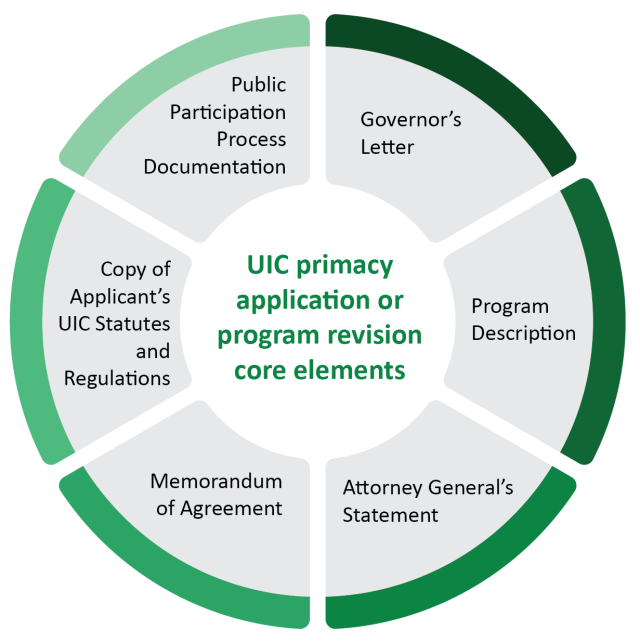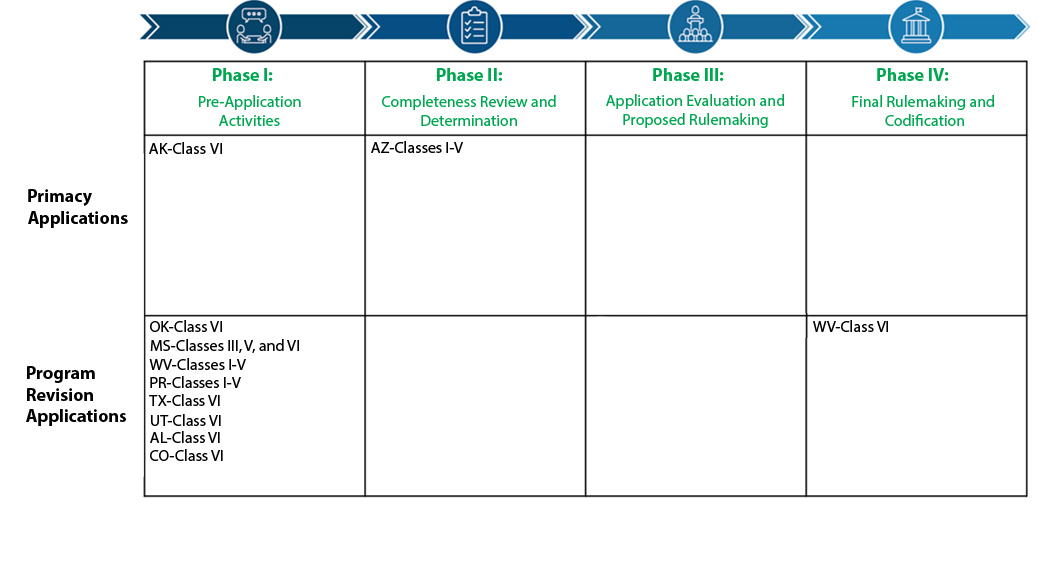Primary Enforcement Authority for the Underground Injection Control Program
On this page:
- What is UIC primary enforcement responsibility (primacy)?
- What states, territories, and tribes have primacy?
- Who implements the program in states, territories, and tribes that do not have primacy?
- What is the process for states, territories, and tribes to apply for primacy or implement a substantial program revision?
- What are the core elements of a primacy application or program revision?
- How should UIC primacy applications address environmental justice?
- What states, territories, and tribes are currently in the primacy application or substantial program revision process?
- What states, territories, and tribes have recently completed a primacy application or substantial program revision process?
What is UIC primary enforcement responsibility (primacy)?
Primary enforcement responsibility, often called primacy, refers to state, territory, or Tribal responsibilities associated with implementing EPA approved UIC programs. A state, territory, or Tribe with UIC primacy, or primary enforcement responsibility, oversees the UIC program in that state, territory, or Tribe.
The Safe Drinking Water Act (SDWA) requires the EPA to develop UIC program requirements that protect underground sources of drinking water (USDWs) from endangerment. The EPA developed UIC program requirements that are designed to be adopted by states, territories, and Tribes.
Primacy programs are established under the SDWA sections 1422 and 1425. Section 1422 applies to all well classes and requires primacy applicants to meet the EPA’s minimum requirements for UIC programs. Section 1425 applies to Class II wells only and requires primacy applicants to demonstrate their standards are effective in preventing endangerment of USDWs.
|
SDWA Section 1422 |
SDWA Section 1425 |
|
|
Program Requirements |
Meets minimum EPA requirements for UIC programs |
Demonstrate standards are effective in preventing endangerment of USDWs |
|
Demonstrate to the EPA that the state, territory, or Tribe has jurisdiction over underground injection and the necessary administrative, civil and criminal enforcement penalty remedies. |
||
|
Well Class Applicability |
· All well classes · Classes I – V · Class VI |
Class II |
What states, territories, and Tribes have primacy?
The EPA has approved UIC primacy programs for multiple well classes in thirty-one states and three territories. If a state, territory, or Tribe does not obtain primacy for all or some UIC well classes, the EPA implements the program directly through one of its regional offices. Currently, the EPA implements the UIC program for all well classes in nine states and two territories. Apart from the Navajo Nation and Fort Peck Class II programs, the EPA directly implements the UIC program in Indian country.
Use your cursor and hover over the states, tribes and territories (all referred to collectively as “State”) in the map below, or refer directly to the table, for state-specific primacy information.
UIC Primacy Map
| Navajo Nation | |
| Fort Peck Tribes | |
| All Other Indian Tribes. |
| EPA manages all well classes. | |
| State has primacy for Class II wells only. | |
| State has primacy for multiple well classes. | |
| State has primacy for all well classes (Classes I, II, III, IV, V and VI). |
What is the process for states, territories and tribes to apply for primacy or implement a program revision?
States, territories and tribes applying for UIC program primacy must follow the UIC primacy application process requirements presented at 40 CFR part 145. Two EPA guidance documents describe the general procedures for the Agency's review and approval of primacy and program revision applications.
- Guidance for Review and Approval of State Underground Injection Control Programs and Revisions to Approved State Programs - provides guidance to the EPA regional offices on the process for the approval of state primacy application and the process for approving program revisions for programs approved under both Safe Drinking Water Act (SDWA) Section 1422 and 1425.
- Guidance for State Submissions Under Section 1425 of the Safe Drinking Water Act (SDWA) - provides guidance on how states may apply for primacy approval under Section 1425 of the SDWA and the criteria the EPA will use in approving or disapproving an application.
The information provided on this webpage is intended to clarify procedures and facilitate transparency and consistency in primacy and program revision evaluations and approvals.

Phase I: Pre-application Activities
Under this phase, the EPA may support a state, territory, or Tribe by:
- Identifying available resources and the critical elements of a primacy application or program revision.
- Meeting to outline the process, address preliminary questions, and determine which well classes may be included in the application.
- Reviewing the applicants draft UIC statutes and regulations, or any other material in the application package.
- Encouraging a comparison with federal regulations using the comparison crosswalk template.
Phase II: Application Evaluation and Completeness Determination
Under this phase, the EPA and the state, territory, or Tribe conducts the following activities:
- EPA receives and reviews complete or mostly complete drafts of applicable critical elements of the primacy application.
- Evaluates each primacy application element and coordinates with applicants to clarify questions and confirm stringency or effectiveness.
- EPA and a state, territory, or Tribe may engage in a continued dialogue to clarify questions.
- A state, territory or Tribe may identify regulatory or statutory changes to implement by the end of this phase.
- The EPA’s regional UIC program verifies the application is complete and transmits it to the National UIC program to initiate rulemaking.
Phase III: Proposed Rulemaking
Under this phase, the EPA conducts the following activities:
- Publishes a proposed rule signed by the EPA Administrator which indicates the EPA’s intent to approve or disapprove of a primacy application or program revision.
- Initiates a minimum 45-day public comment period and holds a public hearing, if requested.
- The EPA may request additional information and/or coordinate with applicants to confirm stringency or effectiveness.
Phase IV: Final Rulemaking and Codification
Under this phase, the EPA conducts the following activities:
- Reviews all public comments provided through the EPA docket and the public hearing.
- Depending on the comments, the EPA may request additional information and/or coordinate with applicants to confirm stringency or effectiveness.
- Drafts the final rule approving, or disapproving, the primacy application or program revision.
- Prepares the final rule package for submission to the EPA Administrator. The final rule package includes: a summary of the public comments and the EPA’s responses; documentation of any changes from the state’s original application and the EPA’s rationale for finalizing the rule with such changes; and the regulatory text that will be codified in 40 CFR part 147 after the program is approved.
- The EPA Administrator signs the final rule for publication in the federal register.
What are the core elements of a primacy application or program revision?

UIC Program regulations at 40 CFR part 145 identify six core elements of a UIC primacy application or substantial program revision.
Each of the six requirements are identified below. All documents are required for a new primacy application. For program revisions, depending on the nature of the UIC program changes, a state, territory, or tribe may need to revise one or more of the six core elements and submit a revised primacy application to the EPA.
| Governor's Letter | Program Description | Attorney General's Statement | Memorandum of Agreement | Copy of Applicant's UIC Statutes and Regulations | Public Participation Process Determination |
|---|---|---|---|---|---|
| A signed letter from the governor of the state requesting approval for UIC program primacy. | A document describing in narrative form the scope, structure, coverage and processes of the applicant’s program. | A certification by a qualified representative of the state, asserting that the state’s statutes, regulations and judicial decisions demonstrate adequate authority to administer the UIC program. | The central agreement setting out the provisions and arrangements between the applicant and the EPA. | SDWA Section 1422: Applicants may incorporate the federal regulations by reference, adopt the federal language verbatim, or draft provisions that are as stringent as the federal requirements. | Documentation of the public participation process the applicant used to notify the public of its intent to apply for primacy. |
| Must specify that approval is sought under sections 1422 or 1425 of the SDWA. | Describes the administration, implementation and enforcement of the applicant’s UIC program. | SDWA Section 1425: Applicants must demonstrate that their Class II regulations are effective in preventing underground injection that endangers USDWs. | |||
| Review an example letter from a recently approved program. | Review and example from a recently approved program. | Review and example from a recently approved program. | Review an example from a recently approved program. | Review an example from a recently approved program. | Review an example from a recently approved program. |
What states, territories, and tribes are currently in the primacy application or program revision process?
Status of state, territory, and tribal primacy and program revision applications

What states, territories, and tribes have recently completed the primacy application or program revision process?
West Virginia
Summary of Action
On January 17, 2025, the U.S. Environmental Protection Agency approved the State of West Virginia’s request for primary enforcement responsibility of Class VI wells under the UIC program. After considering written comments and input from an all-day public hearing on December 30, 2024, the EPA determined that the State of West Virginia’s Class VI UIC program meets all requirements for approval. This action allows the West Virginia Department of Environmental Protection (WVDEP) to issue UIC permits for geologic carbon sequestration facilities as Class VI wells and ensure compliance of Class VI wells under the UIC program within the State. EPA will oversee West Virginia’s administration of the State's UIC Class VI program as authorized under the SDWA.
Review the Pre-publication version of the Final Rule documenting the Agency’s action. For accessibility issues please contact Colin Dyroff by email ([email protected]), or by phone (202-564-3149).
